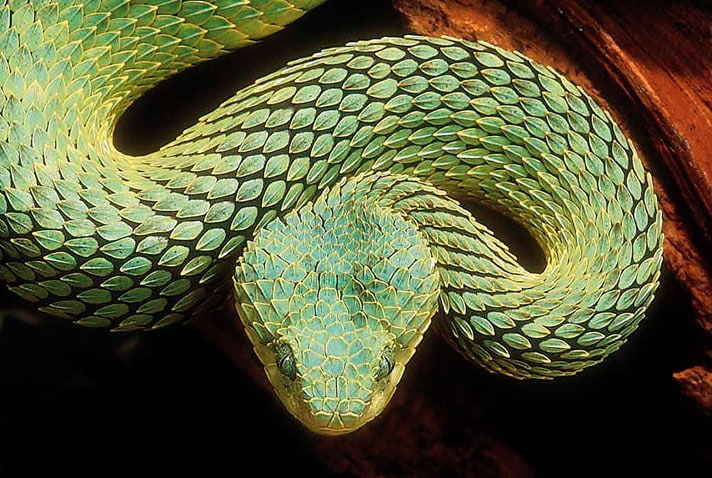In this first of a special two-part article, learn about vipers in general, with emphasis on five true viper species.
Vipers are considered to be one of the most advanced groups of snakes, meaning that they display a large degree of divergence from the ancestral snakes. Depending upon the source, and allowing for taxonomic fluctuations, there are roughly 14 genera and approximately 85 viper species currently recognized.
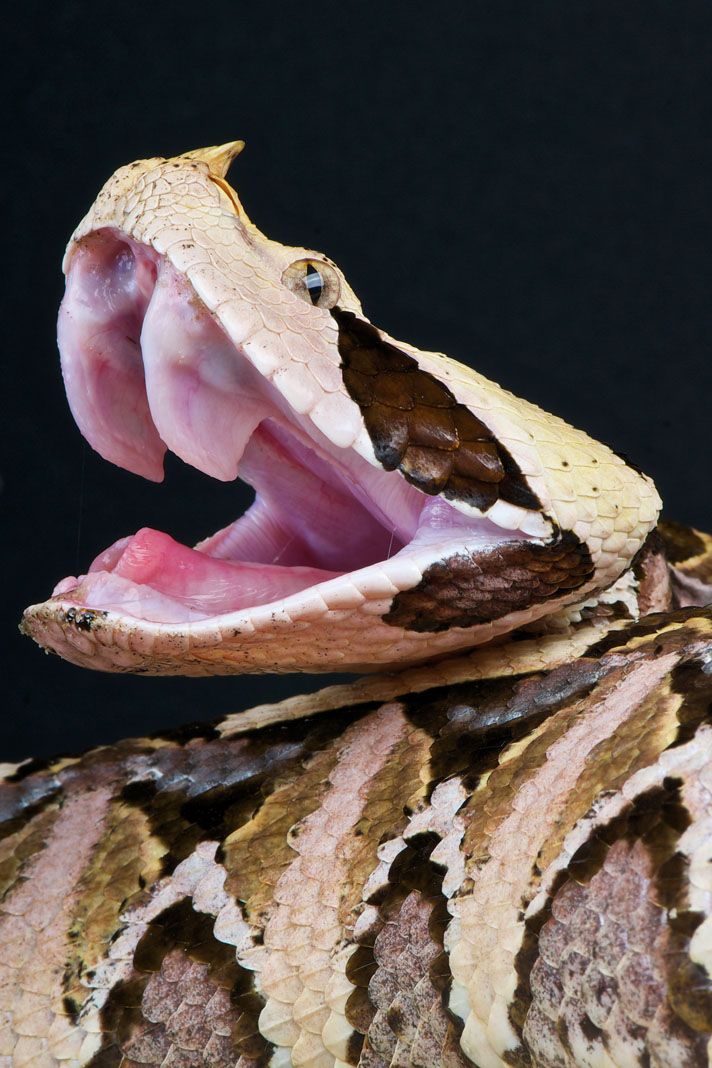
shutterstock
At 2 inches in length, the fangs of the Gaboon viper (Bitis gabonica) are the longest of any venomous snake.
The first authentic viper fossils known are from the early Miocene of Europe and Asia, although it is believed that vipers probably first appeared in Africa. The true vipers are members of the subfamily Viperinae within the family Viperidae, which also includes the subfamilies Causinae (night adders), Azemiopinae (Fea’s viper) and Crotalinae (pit vipers). The true vipers are sometimes referred to as Old World vipers because their range is limited to Africa, Europe and Asia, whereas pit vipers are also found in the New World (the Americas of Earth’s Western Hemisphere).
Vipers tend to be relatively short, stout snakes, with very few species reaching a maximum length of 6 feet. Although there are a few very short forms, as well, most of the true vipers have adult lengths of 2 to 4 feet. For the most part, they are ground-dwelling species, although a few, such as members of the genus Atheris, have invaded trees and bushes to develop an arboreal lifestyle.
The heads of vipers tend to be broad and triangular, in order to accommodate large venom glands that are connected by ducts to the snakes’ hollow, needle-like fangs. Their fangs fold rearward when not in use — a trait known as “solenoglyphous” — which allows them to be much longer than the shorter and more rigidly mounted, or “proteroglyphous,” fangs of elapid snakes (such as cobras, sea snakes, coral snakes and other members of the family Elapidae). Although the eyes of both true and pit vipers feature vertically orientated, elliptical, “cat like” pupils, one of the most notable physical differences between the two is that true vipers lack the temperature-sensitive facial pits that give the pit vipers their name.
Vipers are found in a wide range of habitats, from arid deserts to steaming jungles, and even above the Arctic Circle. The majority of species are primarily nocturnal, although many are also active during daylight. Most of the vipers are ovoviviparous, bearing their young alive, but there are a few species that are oviparous (egg laying).
Most viper species are relatively sedentary in their habits. They are adept ambush predators, meaning they hold still and wait for their prey to come to them. They can strike with lightning speed, embedding their long fangs deeply into their prey to inject venom. The prey animal is usually then released, and the viper will follow its scent until the venom has had time to work. Venom begins to immediately break down the animal’s tissues, making it easier for the viper to swallow its meal (the tissue-destroying properties of viper venom can cause horrific damage to humans or livestock that may be bitten, possibly resulting in serious necrosis and/or the loss of extremities).
Their efficient mechanism of killing allows vipers to tackle large prey with a good degree of safety. Taking large meals reduces the needed frequency of feeding because the snake can take in much more energy with each kill. In addition, the venom apparatus provides an effective means of defense for these slow-moving serpents.
Vipers are a diverse and fascinating group of snakes. Many of them are strikingly beautiful in appearance, with colors and patterns that could almost seem to be designed purely for decorative effect. They have figured into the development and history of mankind from the beginning and have left lingering impressions on our art and culture, and even perhaps in our biology. One school of thought believes that a formative force in the development of primate vision was the need to pick out the shape of a camouflaged serpent on a forest floor or twined within vegetation. The need for this ability persists today in many parts of the world, where the peril of the strike of an unseen snake is an ever-present danger. The combination of an abundance of venomous snakes and minimal available medical care renders snakebite a significant public health risk in many areas.
Now that we know a little about the vipers in general, let’s take a look at five of the true vipers I find the most interesting in greater detail.
Saw-Scaled Vipers (Echis spp.)
Often referred to as carpet vipers, the saw-scaled vipers have the dubious distinction of possibly causing more human fatalities due to snakebite than any other viper species. Notwithstanding their small size — adults rarely attain more than 2 feet in length — saw-scaled vipers are extremely dangerous snakes with an immense range across Asia, Africa and the Middle East. They tend to be quite defensive and are amazingly abundant in some areas.
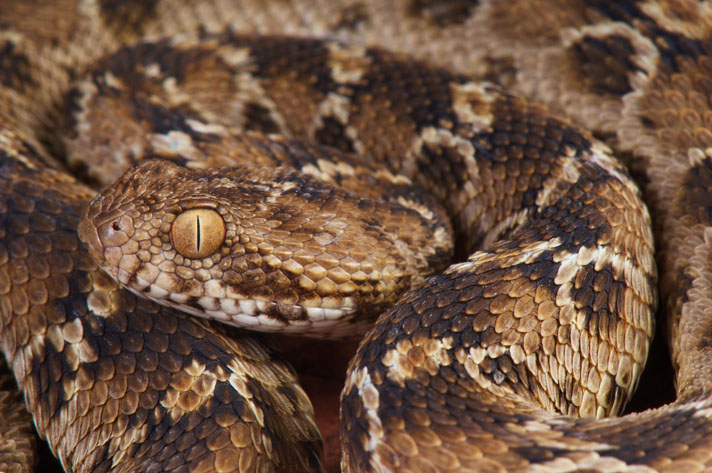
shutterstock
The common name of saw-scaled viper is due to the snakes’ threat display, in which they “saw” their coils together, making a raspy sound. This is an Egyptian saw-scaled viper (Echis pyramidum).
Long considered to consist of only two species — Echis carinatus and E. coloratus — current taxonomic thinking is that the genus is comprised of a much larger number of species, at least 10 or maybe more. Some are egg layers, while others give birth to live young.
Saw-scales get their name from their fascinating threat display of rapidly “sawing” their coils together, causing the scales to rasp against each other while producing a sound somewhat like one might get by rubbing two pieces of sandpaper rapidly together. Watching one of these snakes in a defensive coil is a fascinating experience. Should their display not succeed in warning away an aggressor, saw-scales will strike quickly and savagely. Their venom is extremely toxic and frequently causes the most alarming symptoms, such as uncontrolled bleeding throughout the body. Human fatalities within the saw-scaled vipers’ range are quite common.
Saw-scaled vipers are somewhat drably colored in various shades of brown or tan, which provides excellent camouflage in their normally arid habitats. They frequently bury themselves in the sand, leaving just their eyes exposed above the surface. They are also often found under rocks or surface debris. In soft-sand areas, they often utilize the same side-winding form of locomotion favored by the sidewinder rattlesnake of the American southwest. Saw-scaled vipers consume a variety of prey, including birds, small rodents and lizards, along with invertebrates such as centipedes and insects.
Russell’s Viper (Daboia russelii)
This viper attained a certain measure of fame due to its appearance in the 1892 Sherlock Holmes story, “The Adventure of the Speckled Band.” Although its deadliness was somewhat exaggerated by Sir Arthur Conan Doyle, the Russell’s viper is certainly the most dangerous viper in Asia, and the species is a significant source of snakebite death throughout its range, which covers nearly all of the Indian subcontinent as well as southeast Asia.
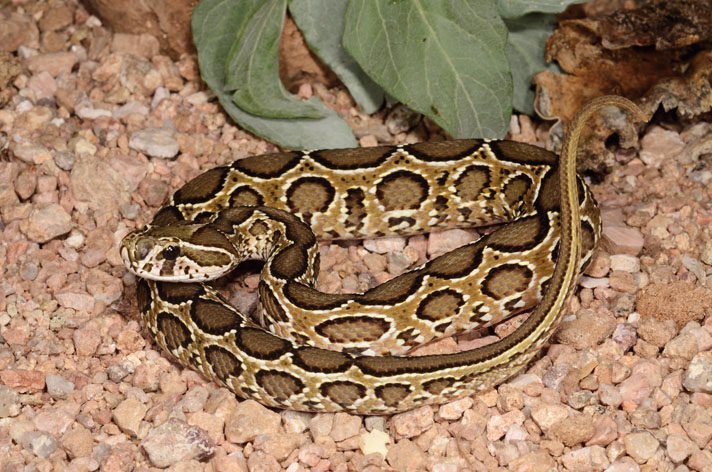
bill love
With a potential length of 5 feet, the Russell’s viper (Daboia russelii) is one of the larger true viper species.
Reaching a maximum size of about 5 feet, this is one of the larger viper species. Currently, two subspecies are recognized: Daboia russelli russelli from India, Pakistan, Bangladesh and Sri Lanka, and D. r. siamensis from Thailand, Myanmar, Cambodia, Indonesia and China.
Russell’s vipers are richly patterned with a reddish brown ground color and three rows of darker spots along the back and sides. The ventral surface is white or yellowish, sometimes displaying a pink wash, and often sprinkled with black spots or half-moons. The overall appearance is an attractive mixture of browns and reds with black and white lines and stripes around the dorsal spots. The face is marked with dark lines behind the eyes.
These vipers utilize a wide variety of habitat, though are most often found in open lowland areas. Thick jungle or forest is usually avoided, and they are often found in close proximity to humans in agricultural zones and even in urban areas. Here, their preferred prey of rodents is found in large numbers.
Russell’s vipers will shelter in piles of rubbish or rodent burrows during the day and emerge after dark, when they are frequently encountered by people along trails and on roadways. Although normally inoffensive, Russell’s vipers defend themselves with vigor when provoked, emitting loud warning hisses and striking with great speed and accuracy. A bite from a Russell’s viper is very deadly, with reported mortality rates of 30 percent in some areas.
Young Russell’s vipers are born alive, and large litters are common. The largest reported litter I am aware of was 65, but 30 or so is not uncommon. Babies are miniature versions of the adults and feed readily on small mice. Years ago, I bred Russell’s vipers on several occasions but eventually stopped due to my inability to find homes for all of the offspring. Once common in U.S. collections, the Russell’s viper suffered severely from outbreaks of ophidian paramyxovirus virus and is now rarely seen in captivity.
Gaboon Viper (Bitis spp.)
These are the giants of the viper clan, sometimes attaining lengths of 6 feet and weights in excess of 17 pounds. Additionally, Gaboon vipers have the distinction of possessing the longest fangs of any venomous snake, with those of a large adult approaching about 2 inches in length. They also are capable of producing the greatest quantity of venom of any snake, with a reported yield on extraction of 9.7ml of venom.
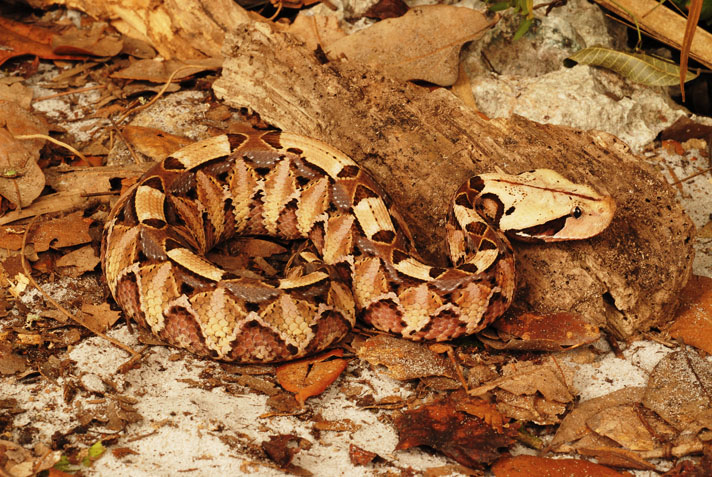
bill love
In addition to possessing the longest fangs, the Gaboon viper (this is a juvenile) is also capable of producing the greatest quantity of venom of any other snake.
For years, all Gaboon vipers were considered to belong to the single species Bitis gabonica, with two subspecies, the East African Gaboon (B. g. gabonica) and the West African Gaboon (B. g. rhinoceros). These are now considered to be distinct species: B. gabonica and B. rhinoceros. Together, they range over large parts of sub-Saharan Africa, from the northwestern portion to east Africa and down into South Africa. Gaboon vipers can be distinguished easily by the presence of distinct horn-like structures on the nose of the West African species; East African Gaboons lack these nasal horns.
The color and pattern of the Gaboon vipers might best be described as vivid or even bizarre. The ground color is usually a buff or beige overlaid with a variety of differently shaped and colored markings. Looking at one of these vividly marked snakes, it is difficult to imagine how effective the coloration is as camouflage when the animal is motionless on the forest floor, but effective it was.
When I worked at Atlanta Zoo, I cared for a large West African Gaboon that was on display in an exhibit furnished very simply with a dead stump and floored with dead leaves. On many occasions, I had to look very carefully to pick out the snake, and I frequently observed zoo visitors examining the exhibit and then moving on while saying, “There’s nothing in this one,” despite the fact that they were within inches of one of the world’s largest venomous snakes lying fully exposed on the floor of the cage. Gaboons really do blend in that well; in the wild, they must be nearly invisible.
Read More
Top 10 Venomous North American Snakes
Gaboon vipers are the consummate ambush predators. Lying motionless along a game path, they wait until a suitable prey animal comes within reach and then launch a well-placed strike. Unlike many vipers, they normally keep a grip on the prey until the venom takes effect, and will frequently lift the forepart of their bodies into the air while holding the animal clear of the ground until its struggles cease. Large Gaboon vipers have been known to feed on animals as large as small antelope, such as dik-dik, as well as young monkeys.
Fortunately for the human inhabitants of Gaboon viper country, these snakes are normally extremely reluctant to bite. There are reports of people treading directly on a camouflaged viper without provoking a strike. Still, the results of a Gaboon bite, though rare, can be horrific. The combination of the long fangs, copious venom yield and a virulent tissue-destroying venom make for an extremely serious combination. A Gaboon bite nearly ended the life of a young Marlin Perkins, later of Mutual of Omaha’s Wild Kingdom fame, at the St. Louis Zoo in 1928. Their seeming placidity leads many to take foolish chances with captive Gaboons, and when they do decide to strike, it is amazingly fast and although they are normally easy-going, an aroused Gaboon is a force to be reckoned with. Anyone maintaining these animals in captivity should never, under any circumstances, take their good nature for granted.
Bush Vipers (Atheris spp.)
As their collective name suggests, the bush vipers of the genus Atheris are the only vipers that routinely dwell aboveground. The genus consists of a dozen or so species that are largely confined to central Africa, where they inhabit a steadily shrinking and fragmented rain forest habitat.
Bush vipers are normally mostly green in coloration, although there is quite a bit of variation between, and even within, the species. The scalation of many is extremely rough, especially around the head, giving bush vipers an unusual appearance. They are normally small in size, with most being about 2 feet long at adulthood, and larger species such as the green bush viper reaching a maximum length of around 2½ feet. They are rarely encountered in the wild and even less frequently known to bite humans, although some of the species are quite spirited in defending themselves if necessary.
By far the most common bush viper found in collections is the green bush viper (A. squamigera), which has become fairly well established among hobbyists. Other species are rarely seen in captivity.
As might be inferred from its common name, the coloration of this species is usually some shade of green dorsally, although occasional specimens can be yellow, red, dark gray or black. Some display lighter cross-bands. The belly is a paler olive green or yellowish, and often mottled with black. The tail tip is usually colored white.
The green bush viper is found over large parts of central and western Africa. It inhabits densely forested or rain forest areas, where it hunts at night for small mammals. It is reported to descend close to the ground in order to ambush scurrying mammals from above; frogs and lizards are also consumed, along with occasional birds and other snakes. During the day, the green bush viper may be found higher in the trees, frequently basking in the sun above the foliage. As mentioned, this is one of the larger species of the genus, with females reaching about 2½ feet in length and males a bit less. Young green bush vipers are born alive in litters that usually number five to 10, although larger litters are known.
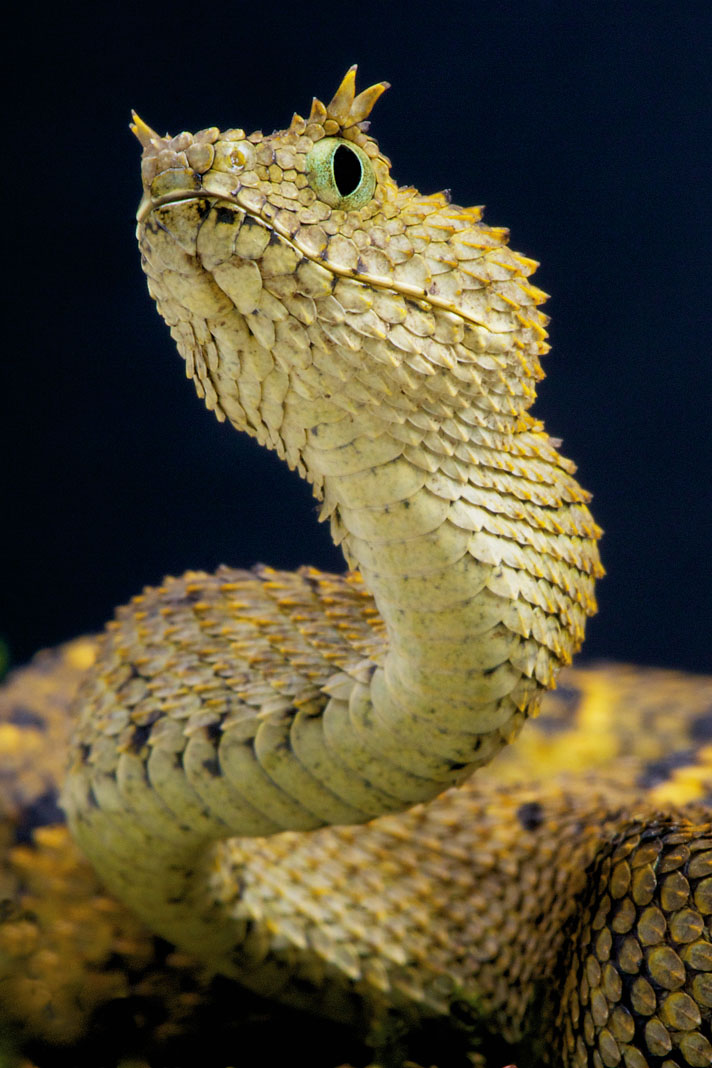
reptiles4all/shutterstock
This is an Usambara horned viper (Atheris ceratophora). As the collective name of “bush viper” indicates, vipers of the genus Atheris are the only species that routinely dwell aboveground.
Although Atheris are frequently reported as being only mildly dangerous to humans, it is quite possible that this is more an artifact of the limited number of known envenomations than of the actual potential of the snakes to cause harm. At least one reported fatality is known from an A. squamigera bite, and other reports exist in which alarming symptoms developed. No antivenin is produced for any vipers of this genus, and it seems that there is only minimal neutralization of their venom by that produced for other species. Any bush viper species should therefore be treated with extreme caution.
Long-Nosed Viper (Vipera ammodytes)
Named after the single, elongated horn at the tip of its snout, the long-nosed viper is a stout-bodied species with wide distribution throughout southern Europe, along the Mediterranean and Baltic coasts. It has the distinction of being the most dangerous venomous snake of Europe, with a potent venom that it is not at all averse to using when disturbed. The maximum length of a long-nosed viper is around 3 feet, with males growing slightly larger than females.
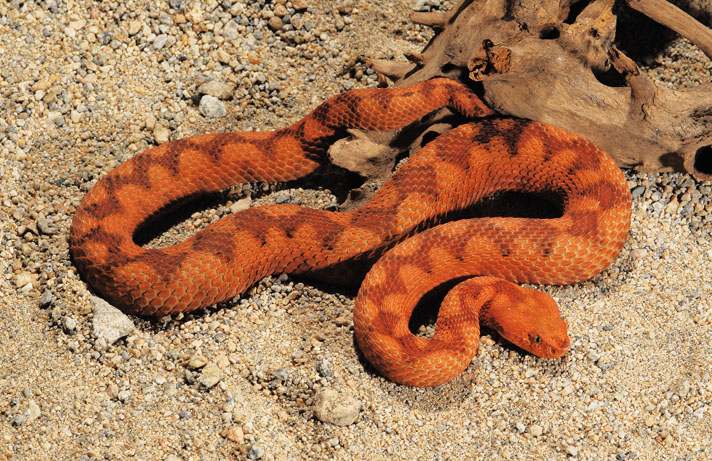
bill love
The orange phase of the long-nosed viper is a particularly eye-catching snake.
There are several subspecies of V. ammodytes currently recognized, with the two most commonly reported being V. a. meridionalis from Albania, Greece, and Turkey and V. a. montandoni from Bulgaria and Romania. The nominate subspecies V. a. ammodytes is found in Austria, Italy and former Yugoslavia, extending into parts of Romania and Bulgaria, as well. One subspecies, V. a. transcaucasiana, from Turkey and parts of the former U.S.S.R is now considered by many to be a distinct species, V. transcaucasiana.
Many long-nosed vipers are outstandingly attractive, and they are quite variable in color. The ground color typically varies from light gray to a brilliant red orange with a dark, zig-zag stripe running the length of the back. The underside is usually some shade of gray, yellow brown, or pinkish and heavily suffused with darker spots or mottling. Melanistic examples are known, as well.
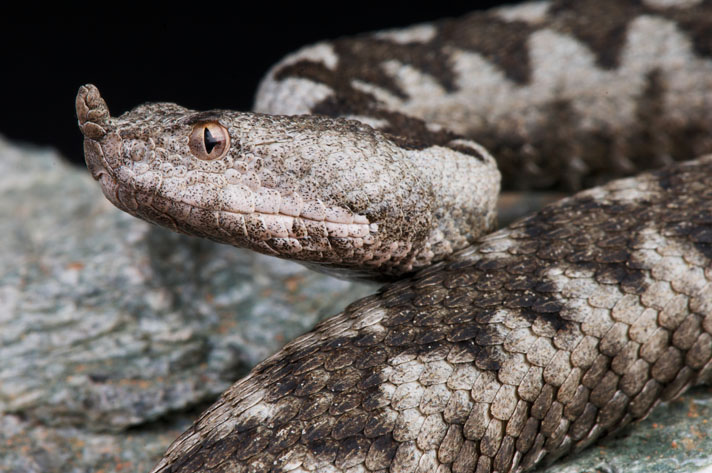
shutterstock
Looking at this photo, it’s easy to see how the long-nosed viper (Vipera ammodytes) came by its common name.
The favored habitat of long-nosed vipers is usually dry and rocky with sparse vegetation. They are rarely found in heavily wooded areas, although they do utilize forest edges and clearings and are often found in disturbed areas, such as around stone walls, road and railway embankments, and farms. They are normally found in hilly or mountainous areas and have been reported at altitudes of 6,500-plus feet.
Food includes small rodents and birds, and occasionally frogs, lizards and invertebrates such as centipedes. Long-nosed are active at all times of the day, though with a preference for nighttime during the hottest part of the year. Frequently found basking on stone walls, rock ledges and boulder piles, they normally are reluctant to move off when discovered, hissing loudly when disturbed and defending themselves by striking vigorously.
Long-nosed viper venom is highly toxic, and serious human envenomations are fairly common. With several other viper species sharing its range, it is difficult to know exactly how many bites V. ammodytes is responsible for, but it is likely they account for quite a number each year. Similarly, it is impossible to know exactly how often fatalities occur. Symptoms include swelling, discoloration and pain, and it is often reported that bite victims experience severe nausea, tingling and dizziness. Bites by captive specimens are fairly frequently reported, and great care should be taken with these snakes that are quite willing to punish lapses in a keeper’s judgment.
Be sure to read part two of this article will include rattlesnakes, the bushmaster, eyelash viper and others.
For those wishing further viper information, I recommend the books True Vipers: Natural History and Toxinology of Old World Vipers (2003) by Mallow, Ludwig and Nilson; Venomous Snakes: Snakes in the Terrarium (fourth edition, 2005) by Trutnau; and Poisonous Snakes (revised edition, 1989) by Phelps. An account of Marlin Perkins’ Gaboon viper bite can be found in Snakes of the World (1931) by Ditmars, and it makes fascinating, if gruesome, reading.
Peter Lindsey was a reptile keeper at the Atlanta Zoo, supervisor of reptiles at the Louisiana Purchase Gardens & Zoo, and a keeper at the Kentucky Reptile Zoo. He is currently the curator of live exhibits at the Chiricahua Desert Museum in Rodeo, New Mexico (chiricahuadesertmuseum.com).

